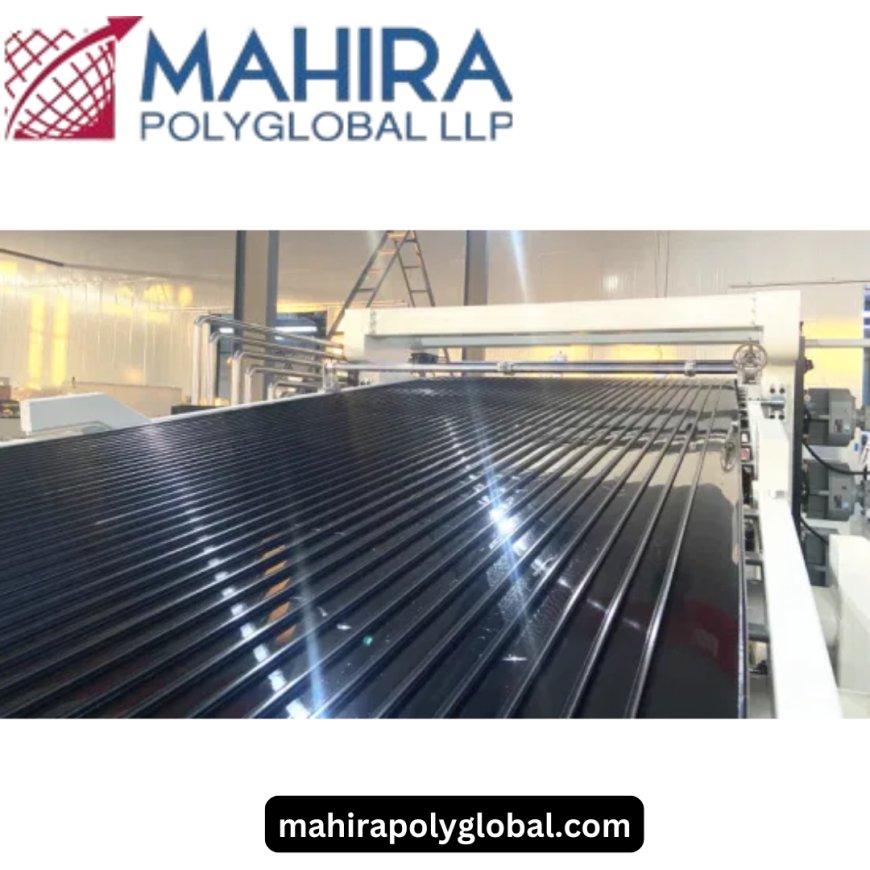HDPE T-Rib Liner Sheets: A Comprehensive Guide to Concrete Protection

In the realm of construction and infrastructure, the integrity and longevity of concrete structures are paramount. High-Density Polyethylene (HDPE) T-Rib liner sheets have emerged as a vital solution for safeguarding these structures against environmental and chemical degradation. This Mahira Polyglobal LLP delves into the characteristics, applications, installation processes, and benefits of T-Rib HDPE liner sheets in India while answering common questions regarding their use.
1. Understanding HDPE T-Rib Liner Sheets
HDPE T-Rib liner sheets are specially designed protective liners made from high-density polyethylene, a versatile thermoplastic known for its strength and durability. The unique T-rib design features raised ribs that enhance the mechanical bond between the liner and the substrate, typically concrete. This innovative design not only provides excellent anchorage but also ensures that the liner can withstand the stress of various environmental conditions, making it suitable for diverse applications.
These liner sheets are particularly valuable in settings where concrete surfaces are exposed to aggressive chemicals, moisture, and extreme weather conditions. Their superior chemical resistance prevents corrosion, erosion, and degradation of the underlying concrete, thus extending its lifespan. As industries in India grow, the demand for such protective solutions has increased, prompting a rise in the utilization of T-Rib HDPE liner sheets.
2. Applications of T-Rib HDPE Liner Sheets in India
The versatility of T-Rib HDPE liner sheets makes them ideal for a wide array of applications across different sectors. In India, they are predominantly used in the following areas:
-
Wastewater Treatment Plants: These facilities require robust protection against corrosive sewage and industrial effluents. T-Rib HDPE liners effectively shield concrete tanks and channels from chemical attacks, ensuring the structural integrity of treatment plants.
-
Chemical Storage and Containment: Industries that handle hazardous chemicals rely on T-Rib liners to prevent leakage and contamination of surrounding areas. The chemical resistance of HDPE ensures that the concrete remains protected from spills and leaks.
-
Landfill Sites: T-Rib HDPE liner sheets play a critical role in preventing leachate migration into the environment. They create an impermeable barrier that protects groundwater from contamination, making them essential in waste management practices.
-
Tunnels and Underground Structures: In tunnel construction, these liners provide waterproofing and protection against water ingress. Their flexibility allows them to adapt to the shifting conditions often encountered underground.
As urbanization and industrial activities increase in India, the application of T-Rib HDPE liner sheets is becoming more prevalent, ensuring that vital infrastructure is protected from the elements.
3. The Importance of Proper Installation
The effectiveness of HDPE T-Rib liner sheets installation cannot be overstated. A proper installation process ensures that the liner adheres securely to the concrete substrate, providing optimal protection against potential damage. The installation generally follows these steps:
-
Surface Preparation: Before installation, the concrete surface must be clean, dry, and free from any debris. This step is crucial for ensuring a strong bond between the liner and the concrete.
-
Embedding the Liner: The T-Rib liner sheets are embedded into freshly poured concrete. The unique ribbed design provides a mechanical anchor, allowing the concrete to bond effectively with the liner.
-
Seam Welding: After placing the liner, the seams between individual sheets are welded together. This creates a continuous, impermeable barrier that prevents water and chemicals from penetrating.
-
Quality Checks: Post-installation, rigorous quality checks are conducted to ensure that the liner is securely attached and that there are no weak points or gaps in the seams.
Professional installation is critical, as improper techniques can lead to liner failure, resulting in costly repairs and structural damage. In India, several experienced contractors specialize in the installation of T-Rib HDPE liner sheets, ensuring high standards of quality and safety.
4. Benefits of Using T-Rib HDPE Liner Sheets
The advantages of using T-Rib HDPE liner sheets are numerous, making them an ideal choice for protecting concrete structures. Here are some of the key benefits:
-
Chemical Resistance: One of the standout features of HDPE is its exceptional resistance to a wide range of chemicals, including acids, bases, and solvents. This property ensures that the concrete remains unscathed even in harsh environments.
-
Durability and Longevity: T-Rib HDPE liners are designed to withstand mechanical stress and environmental factors such as UV radiation, moisture, and temperature fluctuations. Their durability significantly extends the lifespan of concrete structures.
-
Ease of Installation: Compared to other protective methods, T-Rib HDPE liner sheets are lightweight and easier to handle, which streamlines the installation process and reduces labor costs.
-
Cost-Effectiveness: While the initial investment may be higher than traditional coatings, the long-term savings on maintenance and repairs make T-Rib liners a cost-effective solution for infrastructure protection.
The combination of these benefits positions T-Rib HDPE liner sheets as a leading choice for industries seeking reliable and long-lasting protection for their concrete assets.
5. Environmental Impact and Sustainability
The increasing focus on sustainability in construction practices has amplified the importance of HDPE T-Rib liner sheets. These liners contribute to environmental protection in several ways:
-
Reduced Maintenance Needs: By extending the lifespan of concrete structures, T-Rib liners minimize the need for frequent repairs and replacements. This reduces the overall resource consumption associated with construction activities.
-
Recyclability: HDPE is a recyclable material, meaning that at the end of their life cycle, T-Rib liner sheets can be reprocessed and reused in various applications. This aligns with the principles of a circular economy.
-
Preventing Groundwater Contamination: In landfill applications, the use of T-Rib liners prevents hazardous leachate from contaminating groundwater sources, contributing to public health and environmental safety.
As industries in India adopt more sustainable practices, the role of T-Rib HDPE liner sheets in promoting environmentally friendly infrastructure solutions will continue to grow.
6. Case Studies and Real-World Applications
Several successful projects in India have demonstrated the effectiveness of T-Rib HDPE liner sheets in protecting concrete structures. For instance, a major wastewater treatment plant in Mumbai utilized these liners to safeguard its concrete tanks from corrosive sewage. The installation not only enhanced the longevity of the facility but also reduced operational costs associated with maintenance.
In another case, a chemical storage facility in Gujarat implemented T-Rib liners to protect its concrete containment walls from chemical spills. The liners provided a reliable barrier, ensuring that no hazardous materials leaked into the surrounding environment, thereby complying with stringent regulatory requirements.
These case studies highlight the adaptability and effectiveness of HDPE T-Rib liner sheets across various applications, showcasing their importance in modern infrastructure projects.
7. Conclusion: The Future of Infrastructure Protection
As the demand for robust and resilient infrastructure grows in India, the role of T-Rib HDPE liner sheets India in protecting concrete structures becomes increasingly critical. Their unique properties, combined with the benefits of ease of installation and sustainability, position them as a leading solution in the construction industry. By providing excellent protection against chemical corrosion, moisture, and mechanical wear, T-Rib HDPE liners contribute significantly to the longevity and performance of concrete structures.
Investing in high-quality T-Rib HDPE liner sheets not only safeguards vital infrastructure but also aligns with the broader goals of sustainability and environmental protection. As industries continue to evolve, the adoption of these advanced liners will play a pivotal role in ensuring the resilience of concrete assets.
Frequently Asked Questions (FAQs)
-
What are the key benefits of using T-Rib HDPE liner sheets?
T-Rib HDPE liner sheets offer excellent chemical resistance, durability, ease of installation, and long-term cost-effectiveness. They significantly extend the lifespan of concrete structures and minimize maintenance needs. -
In which industries are T-Rib HDPE liner sheets commonly used in India?
These liners are widely used in wastewater treatment plants, chemical storage facilities, landfill sites, and tunnels, where they protect concrete from chemical degradation and environmental damage. -
How are HDPE T-Rib liner sheets installed?
Installation involves embedding the liner sheets into freshly poured concrete, followed by welding the seams between sheets to create a continuous barrier. Proper surface preparation and professional expertise are essential for effective installation. -
Are T-Rib HDPE liner sheets environmentally friendly?
Yes, they contribute to sustainability by reducing maintenance needs, being recyclable, and preventing groundwater contamination in landfill applications, thus promoting environmentally responsible construction practices.
What's Your Reaction?






















